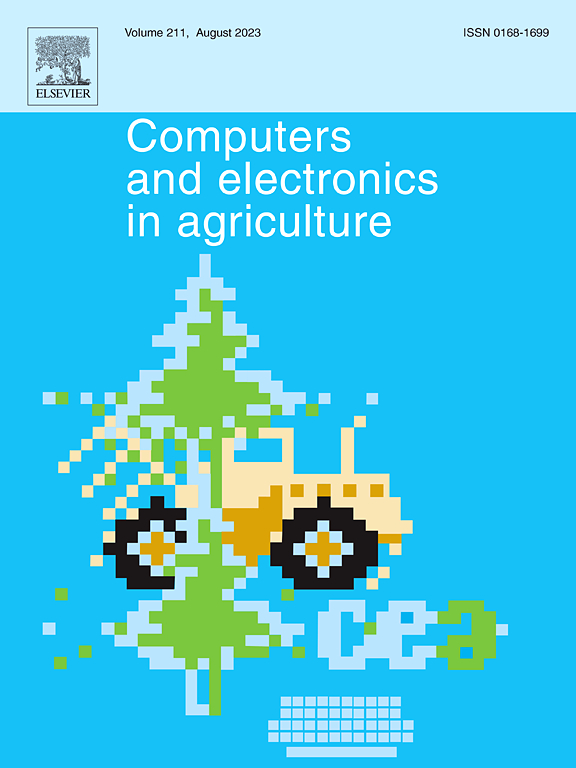使用gan和航空图像进行精准农业操作的视觉到近红外图像转换
IF 8.9
1区 农林科学
Q1 AGRICULTURE, MULTIDISCIPLINARY
引用次数: 0
摘要
计算机视觉和人工智能(AI)技术的快速发展,以及传感系统和无人机(uav)的进步,深刻影响了精准农业(PA)等各个领域。在作物监测和提高产量方面,PA的核心操作是使用被称为植被指数(VIs)的逐像素操作将视觉和近红外(NIR)波长结合起来。然而,部署昂贵的多光谱传感系统限制了现有PA解决方案的可扩展性。朝着这个方向,生成对抗网络(gan)可以用于将视觉图像转换为近红外表示,从而能够利用价格合理的现成视觉传感器,降低系统成本和复杂性。然而,现有的基于gan的光谱域转换方法往往局限于生成伪真实感图像的着色模型,而忽略了目标域的关键光谱特征。这些合成图像通常是根据其视觉合理性而不是光谱特征的一致性来评估的。在精准农业的背景下,这种从视觉到近红外域的转换可能导致不准确的VI计算和不可靠的植被健康估计,使合成数据的可用性受到质疑。为了克服这些限制,我们提出了一种模型不可知的gan修改方法,利用翻译过程中VIs的语义信息。我们的方法在GAN架构中引入了一个额外的分支,从输入的RGB和生成的近红外图像中计算归一化植被指数(NDVI)。通过反向传播额外的分支损耗,我们的方法强制网络产生有意义的近红外表示,准确地保留域的光谱特征。我们在两种广泛使用的GAN架构Pix2Pix和CycleGAN上部署了我们的方法,并在相关数据集上评估了合成结果。实验结果表明,该方法能够提供准确、有意义的近红外图像转换。合成图像在近红外光谱属性下保持其语义上下文,适用于精确VI计算、植被健康估计和相对精准农业应用中的高效利用。本文章由计算机程序翻译,如有差异,请以英文原文为准。
Visual to near-infrared image translation for precision agriculture operations using GANs and aerial images
The rapid growth of computer vision and artificial intelligence (AI) techniques, along with advancements in sensory systems and unmanned aerial vehicles (UAVs), have profoundly impacted various fields such as Precision Agriculture (PA). A core operation in PA for crop monitoring and yield improvement is the combination of visual and near-infrared (NIR) wavelengths using pixel-wise operations known as Vegetation Indices (VIs). However, deploying costly multi-spectral sensory systems limits the scalability of existing PA solutions. Towards this direction, Generative Adversarial Networks (GANs) can be employed for transforming visual images to near-infrared representations, enabling the utilization of affordable off-the-shelf visual sensors and reducing system cost and complexity. Nevertheless, existing GAN-based methods for spectral domain translation often are limited to colorization models that produce pseudo-realistic images, neglecting the crucial spectral characteristics of the target domain. These synthetic images are commonly evaluated based on their visual plausibility rather than the spectral characteristic’s consistency. In the context of precision agriculture, such translations from visual to NIR domain may lead to inaccurate VI calculations and unreliable vegetation health estimation, making the usability of the synthesized data questionable. To overcome these limitations, we propose a model-agnostic modification for GANs that leverages the semantic information of VIs in the translation process. Our approach introduces an additional branch to the GAN architecture, calculating the Normalized Difference Vegetation Index (NDVI) from the input RGB and the generated NIR image. By backpropagating the additional branch loss, our method enforces the network to produce meaningful NIR representations that accurately preserve the domain’s spectral characteristics. We deploy our approach on two widely used GAN architectures, Pix2Pix and CycleGAN, and evaluate the synthesized results on relevant datasets. Experimental results demonstrate that the proposed method provides accurate and meaningful translations of visual to NIR images. The synthesized images maintain their semantic context under the near-infrared spectral attributes, making them suitable for precise VI calculations, vegetation health estimation, and efficient utilization in relative precision agriculture applications.
求助全文
通过发布文献求助,成功后即可免费获取论文全文。
去求助
来源期刊

Computers and Electronics in Agriculture
工程技术-计算机:跨学科应用
CiteScore
15.30
自引率
14.50%
发文量
800
审稿时长
62 days
期刊介绍:
Computers and Electronics in Agriculture provides international coverage of advancements in computer hardware, software, electronic instrumentation, and control systems applied to agricultural challenges. Encompassing agronomy, horticulture, forestry, aquaculture, and animal farming, the journal publishes original papers, reviews, and applications notes. It explores the use of computers and electronics in plant or animal agricultural production, covering topics like agricultural soils, water, pests, controlled environments, and waste. The scope extends to on-farm post-harvest operations and relevant technologies, including artificial intelligence, sensors, machine vision, robotics, networking, and simulation modeling. Its companion journal, Smart Agricultural Technology, continues the focus on smart applications in production agriculture.
 求助内容:
求助内容: 应助结果提醒方式:
应助结果提醒方式:


